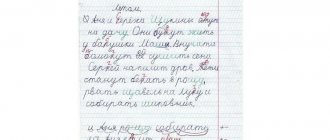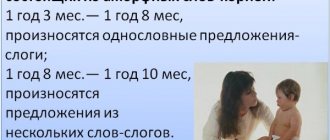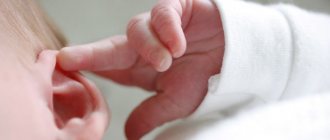Development of phonemic hearing in preschoolers article on speech therapy on the topic
Development of phonemic hearing in preschoolers
Phonemic hearing is very important for a child. Without it, it is impossible to distinguish one speech sound from another, to correctly perceive words and understand them correctly. Experts advise developing such hearing in a baby from the first days of life.
Phonemic hearing is the ability to auditory perception of sound speech, phonemes, the ability to distinguish speech sounds in their sequence in words and the ability to distinguish phonemes that are similar in sound.
Speech sounds are special complex formations unique to humans. They are produced in a child for several years after birth. This process includes complex brain systems and the periphery (speech apparatus), which are controlled by the central nervous system. The long journey of a child mastering the pronunciation system is due to the complexity of the material itself - the sounds of speech, which he must learn to perceive and reproduce.
Phonetic knowledge and skills are a prerequisite for the formation of all 4 types of speech activity: understanding, speaking, reading and writing. In order to adequately perceive audible speech, you need to have developed phonemic hearing, thanks to which we distinguish words by their sound. In addition, developed phonetic abilities allow us to penetrate beyond the original meaning of a word: by the intonation of speech, we can grasp the meaning that the speaker puts into what he is telling us about.
A child with undeveloped phonemic hearing experiences great difficulties in learning to read and write. It is difficult for him to learn to write correctly. Written speech is formed on the basis of oral speech, and problems with phonemic hearing in the future can lead to serious reading and writing disorders (dyslexia and dysgraphia). It is very important not to miss the moment and help the child develop correct, beautiful speech. To achieve this, it is necessary to teach the child not only to clearly pronounce words (sounds), but also to distinguish (differentiate) the sounds of the language by ear.
Advice from a specialist will tell you how to find out that your baby’s phonemic hearing is not sufficiently developed, how and at what age to develop it, when you can solve the problem on your own, and when you need the help of a specialist.
Stages of development of phonemic hearing.
Phonemic hearing begins to develop from the moment the baby is born. Adults should take into account that the baby learns to speak by imitating the people around him: seeing their articulation and hearing their speech. How does phonemic awareness develop and what can adults do at each stage of development to help a child master the skill of differentiating and reproducing speech sounds?
Being in the mother's tummy, the baby perceives music, laughter and other rather loud sounds, but he does not hear speech.
At two weeks - 1 month, the child begins to distinguish speech sounds.
Up to 3 months, the main thing for a child is emotional communication with his mother. You must actively use facial expressions and intonation: speak either quietly or loudly, change the timbre of your voice, pronounce the same word in a squeaky or deliberately deep voice, ask and answer questions. Try to ensure that when talking, the child sees the face of the person talking to him. A child develops by imitating an adult. To learn how to correctly pronounce a particular sound, he must see articulation, that is, lip movements.
3-6 months. At 3 months the baby enjoys listening to music, at 4 months he begins to imitate the sounds he hears, at 5 months he recognizes the voices of loved ones, listens to the sounds of the outside world and to the sounds that he makes.
During this period, the child already craves to communicate with others by shouting. Clearly pronounced vowel sounds appear: “a-u-i” - the so-called humming. Moreover, the baby clearly enjoys their pronunciation. Call him from different places in the room, alternate whispering with loud speech. Repeat the baby’s name in different variations: “Vanya, Vanechka, Vanyusha.” Show how happy you are to communicate. Repeat after the child the combinations of sounds he pronounces, in this case the humming will become more emotional.
6-9 months. At 6 months the baby can distinguish its name by ear, at 7 months it can understand and appreciate meaningful sounds. During this period, the baby begins to babble: combinations of sounds similar to syllables appear in his speech.
9-12 months. From the age of 9 months, the baby begins to identify his favorite and least favorite melodies and makes it clear which one he likes and which one he doesn’t. Every day the babble becomes more and more similar to the words of the native language. As the baby approaches one year of age, intonation and emphasis appear in the baby’s speech. At this age, the child clearly pronounces the first word. From 9 months, the ability to imitate what is heard and repeat certain sounds develops. This is a completely new stage in the development of phonemic hearing.
1-3 years. Phonemic hearing develops intensively, the baby imitates the conversation of adults, copies their intonation. Almost every child at this age has his own favorite words, which he constantly repeats and can sing.
At the age of 1.5 to 2 years, an amazing event occurs - the child begins to speak. This is the brightest, most important and rapid (fast) period of speech development. The baby learns more and more new words, repeats them, and combines them into simple phrases. When talking to your baby, clearly pronounce words and their endings; you also need to carefully pronounce the prepositions in, on, under. They appear first in the baby’s active speech, and it is very important that the child uses them correctly from the very beginning.
3-5 years. In the fourth year of life, phonemic awareness improves so much that it is already clear whether the child has problems with phonemic hearing. At this age, expanded phrases appear in his speech, he must distinguish between hissing and whistling, dull and voiced, hard and soft consonants. Even if the baby cannot yet clearly pronounce them, in the picture he will always show where the bear is, and where the mouse is, where the daughter is, and where the dot is. If he is confused, this is a good reason to seek advice from a speech therapist. After all, by the age of four, a baby should be able to distinguish all sounds.
5-6 years. In the fifth or sixth year of life, sound analysis is formed - the ability to determine the sequence and number of sounds in a word. Only with the skills of analysis and synthesis can a child successfully master reading and writing.
Stages of correctional work on the development of phonemic hearing
The first stage is recognition of non-speech sounds.
Goal: development of auditory perception skills based on non-speech sounds. Objectives: learn to recognize the sounds of toys, musical instruments, voices of animals and birds, sounds of the surrounding reality.
Distinguishing non-speech sounds by ear is the foundation and basis for the development of phonemic hearing.
Game "Guess what sounded." Listen carefully with your child to the sound of water, the rustle of a newspaper, the clinking of spoons, the creaking of a door and other everyday sounds. Invite your child to close his eyes and guess what was heard just now.
Game "Noisy bags". Together with your baby, pour cereal, buttons, and paper clips into the bags. The child must guess by the sound of the shaking bag what is inside.
Game "Magic Wand". Taking a pencil or any stick, tap it on different objects in the house. The magic wand will make a vase, table, wall, bowl, etc. sound. Then complicate the task - let the child guess with his eyes closed which object made the sound.
Game "Blind Man's Bluff". The child is blindfolded and moves to the sound of a bell, tambourine, or whistle.
Game "Let's Clap" The child repeats the rhythmic clapping pattern. For example: two claps, pause, one clap, pause, two claps. In a more complicated version, the baby repeats the rhythm with his eyes closed.
Game “Find a Pair” For the game you need identical boxes with different fillings: cereals, grains, pasta, small metal and plastic objects. The child looks for identical sounding boxes without opening them; by sound.
The second stage is distinguishing speech sounds by timbre, strength and pitch.
Goal: to learn to distinguish by ear the direction of sound, longitude, continuity, tempo, volume, pitch and rhythm on a variety of speech material. Objectives: to learn to reproduce and differentiate rhythms based on visual, auditory and motor analyzers; develop auditory and visual attention, memory, sense of rhythm, ability to change the voice in pitch, strength, duration.
Game "Find out your voice." Record on tape the voices of loved ones and the voice of the child himself, and then ask him to guess who is speaking now.
Game "Loud and Quiet". Agree that the baby will perform certain actions - when you say words loudly and when quietly.
Game "Three Bears". The child guesses which of the fairy tale characters the adult speaks for. A more complex option - the baby himself speaks for the three bears, changing the pitch of his voice Game “Wind” An adult behind the screen hums in a low or high voice: “Oooh!” The child guesses whether the wind is blowing strong or weak and shows the corresponding picture. Game “Sounding Sun” For the game you will need a piece of paper and a yellow pencil. In the middle of the leaf you need to draw a circle - the sun. The teacher behind the screen pronounces a sound or plays a musical instrument. If the sound was long, the child draws a long ray of sunlight, if it was short, a short one. Game “Steamboat Horn” An adult behind the screen hums in a low or high voice: “Oooh!” The child guesses which steamboat is humming, big or small. The third stage is distinguishing words that sound similar to each other.
Goal: development of phonemic perception. Tasks: to develop the ability to distinguish words that sound similar.
Game "Listen and choose". Pictures with similar-sounding words (com, catfish, crowbar) are placed in front of the child. The adult names the object, and the child must pick up the corresponding picture.
Game "True or False". The adult shows the child a picture and names the object, replacing the first sound (forota, korota, morota, gate, porota, horota). The child’s task is to clap his hands when he hears the correct pronunciation.
Game "Racing" An adult offers to organize a race. Children stand in a line at a distance from the speech therapist and, on command, begin to move forward. When everyone hears the word “stop,” they should freeze. The words are pronounced: elephant, moan, stop, drain, stop, stand, knock, hear, elephant, stop, chair, stop, stop. The child who was the most attentive wins. Game “Find a Pair” The child has several pictures in front of him, he must choose a pair so that the words sound similar: bear - bowl. How to complicate the task - choose a rhyme yourself. Game “What is the difference between words?” The child determines how the words differ. For example, kit-cat, beetle-bitch, Masha-porridge, ball-scarf. Game “Extra Word” The child identifies the extra word in the series and explains his choice. For example: ditch, ditch, cocoa, ditch. Poppy, buck, yes, banana.
The fourth stage is distinguishing syllables.
Goal: developing the ability to differentiate syllables. Objectives: learn to differentiate syllables that differ in several or one sound using the material of syllables of different structures.
Game "Let's Clap" The adult explains to the child that there are short and long words. He pronounces them, separating the syllables intonationally. Together with the child he pronounces words (pa-pa, lo-pa-ta, ba-le-ri-na), clapping the syllables.
Game "What's extra?" An adult pronounces a series of syllables “pa-pa-pa-ba-pa”, “fa-fa-wa-fa-fa”, etc. The child should clap when he hears an extra (different) syllable.
Game “Deaf Phones” Children sit in a row, one after another. The adult calls a syllable or series of syllables in the ear of the first child. He whispers to the next one, etc., the last child says out loud what he heard. If a mistake is made, all participants in the game repeat their options and it is determined who made the mistake. The game “Which is different?” An adult pronounces a series of syllables (for example: nu-nu-no, sva-ska-sva, sa-sha-sa, etc.) and invites the children to determine which syllable differs from the others and in what way. Game “Living Syllables” Three children they remember one syllable at a time and go behind the screen, and when leaving there, pronounce them; the rest of the guys determine which syllable was the first, second and third. Later, syllables that make up a word are introduced into the games, for example MA-SHI-NA; after naming the syllable series, the children answer what happened, or find such a picture among others
The fifth stage is distinguishing sounds.
Goal: development of phonemic hearing.
Objectives: learn to isolate a sound from a number of other sounds, syllables, words.
You need to explain to the child that words are made up of sounds, and then play a little.
Game "Who is it?" The mosquito says “zzzz”, the wind blows “ssss”, the beetle buzzes “zzzzzh”, the tiger growls “rrrr”. The adult makes a sound, and the child guesses who makes it.
Game "Who listens better?" Two children stand with their backs to each other. An adult makes a series of sounds. The first one raises his hand if he hears a sound, for example, [f], the second - [w].
Game “Sound Mosaic” A grid is drawn on a piece of paper. If the child hears the sound [a] (as in “the baby is crying”), he paints the cell red, if there is no given sound, he paints it yellow (any other). You can use chips of the specified color.
Game “Catch the Sound” The adult names the words, the child claps his hands if he hears a word with a given sound.
Game "Tangles" Help grandma collect the balls. In a separate basket, place balls with designs that have a given sound in the name.
Game “Speech therapy daisy” The child must make a daisy from petals, choosing only petals with pictures whose names contain a given sound.
Game “Dress up the Christmas tree” To decorate the New Year tree, the child must choose to determine whether there is a given sound in the name of the picture drawn on the Christmas tree ball.
Game “Birthday of Sound” Friends of sound will come to the birthday party - those words that contain this sound. The game can be played either with or without the help of pictures.
Game “Labyrinth” Guide the hero through the labyrinth so that along the way he encounters only objects whose names contain a given sound.
Game “Seat in the carriages” The adult says that animals whose names contain the sound “ZH” (“bug song”) will go in the carriage on the left, and animals whose names have the sound “SH” (“wind song”) will travel in the carriage on the right "). The child determines the presence of given sounds in words and places the animals in their places.
Game “Collect Beads” Laura and Lilya scattered the beads. If there is a picture on the bead whose name is soft [L], the child gives the bead to Lila, if it is hard [L] - to Laura.
Game “Assemble a letter” To play the game you need to make cardboard letters and cut them into several parts. Glue a picture to each particle, the name of which begins with the sound that this letter represents. The child must determine the first sound in a word and assemble a letter from parts.
Game “Help Masha and Mishka” Masha and Mishka want to decorate the house for the holiday with flags. Help them select only the flags with pictures that have the given sound in their names.
Game “Pack a Suitcase” An adult says: “We are going on a trip. We will take with us only those items whose names begin with a certain letter “. The game can be played either with or without the help of pictures.
The sixth stage is the child’s mastery of analysis and synthesis skills.
Goal: to develop skills in sound analysis and synthesis. Objectives: developing the ability to determine the place of a sound in a word, select words with a given sound, compose words from individual sounds, differentiate sounds by hardness - softness, voicedness - deafness, perform phonemic analysis of words; determine the sequence and number of sounds in a word; location of a sound in a word in relation to other sounds
— Game “How many sounds.” The adult names one, two, three sounds, and the child identifies and names their number by ear.
- Game "Let's clap." The adult pronounces a series of words, and the child must clap when he hears a word beginning with a given sound.
— Game “Guess the word.” The child is offered words with a missing sound - they need to be guessed. For example, the sound “l” escaped from the words (...ampa, we...o, ...uk, kuk...a, mas...o).
Game "Who is bigger?" An adult and a child take turns coming up with words with a given sound. The one who names the word last wins. Game “Chain of Words” (analogous to the game “Cities”) An adult and a child take turns naming any words, and each subsequent word must begin with the last sound of the previous word. Game “Collect a Word” An adult pronounces a word by sounds, for example, K, O, T, the child must guess what word it is. Game “Guess the name” To play the game you need to select pictures or toys so that the first letters of their names make up the name. Instructions: “Here is the doll. To guess her name, you need to name the first sounds in the words and make a name from them.” For example: car (M), bus (A), Shrek (W), Watermelon (A) - MASHA. You can complicate the conditions - form a word, for example, using the second or last sounds of words. Game “Words Scattered” The game is intended for children familiar with letters. You need to make a “scattered” word from individual letters. Game “Fourth Extra” An adult names four words, three of which begin with the same sound, and the fourth with a different one. The child identifies the first sounds in words and says which word is the odd one out. Similarly, the fourth odd one is determined by the last sound - then the names of three objects must end with the same specific sound. Game “Beginning, Middle, End” The adult pronounces words with a certain sound, and the child, depending on the position of the sound in the word, says: “beginning” (if the given sound is at the beginning of the word), “middle” (if the given sound is in the middle of the word), “end” (if the given sound is at the end of the word). Game “Find all the objects that begin with the sound ...” An adult asks the child to name all the surrounding objects whose names begin with a certain sound (for example, K). Game “Seat in houses” Toys or the pictures need to be distributed among three houses. In the first house we put those toys whose names have the given sound at the beginning, in the second – those toys whose names have the given sound in the middle, in the third – at the end. Game “Common Sound” You need to guess what sound is in all these words . For example: vase, tooth, dragonfly, jellyfish, hare - the general sound is [z]. Game “Tell Parsley the sound” Parsley names objects (pictures), but does not finish the last sound. The child must suggest the sound that Parsley did not pronounce. Game “Dunno’s Riddles” Dunno sent a letter: “I am sending a piece of paper with words. Guess what words I have in mind.” The letter contains words with missing letters. You need to guess which letters Dunno missed and what words he guessed. Game “Battleship” One syllable is written in each cell of the playing field. The adult names the coordinates, the child writes down the syllables, and then reads the resulting words. Game “Enchanted Word” An evil wizard has bewitched the words so that only the first and last letters remain. Disenchant them. You can offer object pictures as a hint. Game “Tie the Balls” For the game you need an image of balls with drawings. The child determines the hardness/softness of a given sound in the names of the pictures. If the sound in the word is hard, you need to draw a blue thread to the ball, if it is soft, green. Game “Bug” The beetle got sick and all the spots on its wings disappeared. Remember words with the sound [zh], and then dots will appear on its back again.
First stage
The initial stage of work allows you to create a base, a foundation for the development of fine hearing and is suitable for very young children. What do we have to do? Play! For example, the game “Guess what it sounds like.” Everyday situations can be played out: the sound of pouring water, the clinking of dishes, a person’s steps, a cat’s meowing, the rustling of paper.
Other exercises for this stage:
• “Magic sounds”. Together with your child, fill woven bags, opaque plastic containers, or just matchboxes with any “sounding” materials: cereal, metal clips, buttons. You need to guess by the sound what's inside.
• Regular “Zhmurki” is perfect for solving phonemic problems. The child needs to move towards an agreed sound, for example, clapping hands or ringing a bell.
• "Magic Pencil". Give your child a regular pencil and ask him to tap objects of different textures made of wood, glass, metal, and paper.
• “Clap!” The child needs to repeat after the adult the rhythm of clapping and alternating pauses of different lengths. First, the exercise is done with open eyes, then you can make it more difficult: blindfold your eyes with a scarf or simply close them.
To understand how to practice, watch informational videos about the development of phonemic hearing. The video will help you not only understand the logic of the lesson, but also master the most effective working techniques.
Fifth stage
A simple but very important stage for children to understand is the correct pronunciation of sounds. You can introduce the concept of “sound” by saying that each word consists of several sounds. And then play them.
• “I recognized you!” Agree with your child what sound he should recognize. Then the adult pronounces several sounds in a row, and the child, hearing “his” sound, claps his hands.
• “Who does that sound?” To develop phonemic awareness, the simplest exercises are imitations. For example, you need to reproduce the sounds of nature: the buzzing of a mosquito (zh-zh-zh), the growl of a tiger (r-r-r), the singing of a draft or wind (s-s-s).
• You can play with your baby in reverse. The mother makes a characteristic sound, and the child must guess what it sounds like.
Third stage
Recognizing words is a lot of work for the brain. The main thing is to understand how to do exercises correctly to develop phonemic awareness. The preschooler is ready to move to the next level as soon as he begins to cope with tasks accurately.
• "Right wrong". Prepare bright pictures depicting different objects. Show it to the baby and name it, but not correctly, but replacing the first letter of the word with another. For example, instead of a cow - a hog, instead of a chair - ftul, instead of a cup - porridge, etc. Having heard the correct word, the child claps his hands or stamps his foot.
• “Choose.” Glue pictures on cardboard with words that sound similar (cat-bear-mouse; onion-beetle-bitch; goat-braid-dew). Mom says the word, and the child chooses the correct picture.
Fourth stage
Learning to distinguish syllables. Here it is important to give a primary concept of what a syllable is. You can start with the fact that words can be short or long. Then, clapping your hands, use intonation to divide the words into parts according to vowel sounds.
• The child first pronounces words together with his mother, then tries to divide them into parts independently. We say and clap: ba-bush-ka, pal-ka, cat-ka, ma-ma, for-the-weight-ka, lo-pat-ka, blood-wat-ka, etc. Once the child has grasped the essence, we ask him to clap the words on his own.
• "Get out". The child’s task is to hear which syllable is the odd one in the row. For example, an adult says: shi-shi-shi-zhi-shi. When you hear a loud “zhi”, you need to clap.
Probable Causes
The development of phonemic hearing is influenced by the upbringing environment, the example of speech in the family, the state of the peripheral nervous system, etc.
Among the most likely causes of the violation are the following:
- pedagogical neglect;
- hearing loss;
- head injuries, hearing and speech pathologies;
- hyperactivity;
- weakening of the body, serious or frequent illnesses, especially at an early age;
- diseases of the thyroid gland and digestive organs;
- neurological disorders.
To identify the exact cause, it is necessary to consult an ENT specialist, neurologist and speech therapist as early as possible. Sometimes, in addition to the development of phonemic hearing, drug or surgical treatment is required: cutting the hypoglossal ligament, taking central nervous system stimulants.
Phonemic hearing is very important for the development of correct speech. It is necessary not to miss the moment and pay due attention to it at the age of 4–6, so that the child learns easily at school and does not face ridicule from his peers. It is better if the method of hearing development is developed individually, taking into account all the characteristics of the baby.
At what age should you start classes?
The process of developing phonemic hearing in children is individual. It happens that a child begins to perfectly catch sounds and speak at 1.5–2 years. But more often, active formation occurs at the age of 4 years and continues until 5–6 years. At the same time, the most sensitive and significant period of development remains the first years of life.
If up to 2 years of age you talk to your child correctly, without babying, read poems that he understands, and learn simple phrases, then the risk of phonemic hearing disorders decreases significantly. In other words, classes can be conducted from a very early preschool age. There are a lot of exercises and games for the development of phonemic hearing in children 1 year old, 2-3 years old and older. In each case, tasks are selected that correspond to the child’s capabilities.
Important. The optimal time for the development of phonemic hearing is preschool age. Further solving existing problems will become increasingly difficult, and after 9 years it will be almost impossible.
Second phase
At the next level, you need to show the child the difference in the quality of human speech.
• “Who is speaking?” Record on a voice recorder the voices of adults familiar to the child (mother, grandmother, father, brother or sister) and, of course, the voice of the baby himself. The path guesses who the voice belongs to.
• "Three Bears". This is a simulation exercise. Read the story of the three bears together and then speak for the characters. The child should guess when mommy bear, daddy bear and cub speak.
• “Loud or quiet?” Think of actions that the child should perform when his mother’s voice is quiet and when his voice is loud.
![Hard and soft sound [d]](https://ls-kstovo.ru/wp-content/uploads/tverdyj-i-myagkij-zvuk-d3-330x140.jpg)




